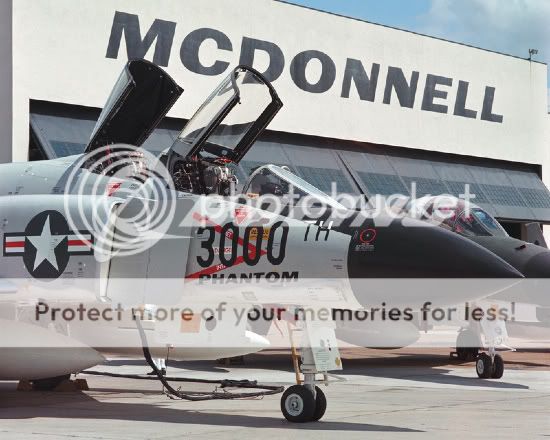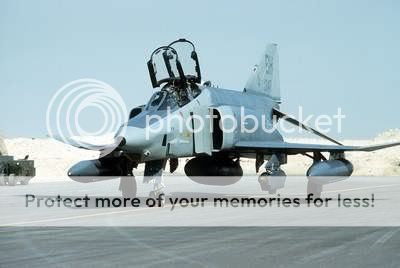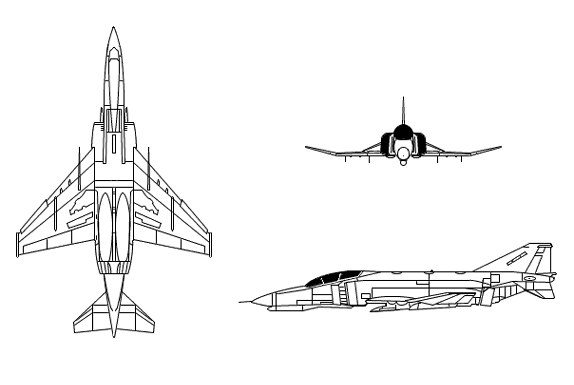It looks like you're using an Ad Blocker.
Please white-list or disable AboveTopSecret.com in your ad-blocking tool.
Thank you.
Some features of ATS will be disabled while you continue to use an ad-blocker.
0
share:
Phifty Phantastic Years
Start off trying to build an attack airplane. Change the mission to air defense. Change the engines. Demand a bigger radar. Hit all kinds of stability nasties in the wind tunnel and drastically change the shape to fix them. Pick the airplane for production, rather than another aircraft that's less expensive and has a greater range.
It doesn't sound like a recipe for a classic, but it worked in the case of the McDonnell F4H-1 Phantom II, which made its first flight 50 years ago yesterday (May 27, 1958).
The jet did start off as a grown-up, twin-engine development of the F3H Demon, an ill-starred and mediocre aircraft of the 1950s, and was originally designated AH-1 (A for attack) when it was ordered in 1954. In the following year the mission was changed to air defense and the aircraft was redesigned around the new General Electric J79 engine. The bigger radar was adopted in August 1957 - it gave the fighter its characteristic droop-nosed profile, although the first few aircraft had the original smaller nose and a flat-topped cockpit.
Stability problems were solved by drooping the horizontal stabilizers by 23 degrees, bending the wingtips up by 12 degrees and installing an aileron-rudder interconnect system. The air inlets incorporated shovel-like variable ramps and the jetpipes were cut off under the tail, which was protected from the heat of the exhaust by metal shingles. The great Bill Gunston recalls the staff of Flight magazine in London chuckling over the first pictures: "They must have got everything wrong and tried to fix it", was the general conclusion.
link

How many more years to go
Start off trying to build an attack airplane. Change the mission to air defense. Change the engines. Demand a bigger radar. Hit all kinds of stability nasties in the wind tunnel and drastically change the shape to fix them. Pick the airplane for production, rather than another aircraft that's less expensive and has a greater range.
It doesn't sound like a recipe for a classic, but it worked in the case of the McDonnell F4H-1 Phantom II, which made its first flight 50 years ago yesterday (May 27, 1958).
The jet did start off as a grown-up, twin-engine development of the F3H Demon, an ill-starred and mediocre aircraft of the 1950s, and was originally designated AH-1 (A for attack) when it was ordered in 1954. In the following year the mission was changed to air defense and the aircraft was redesigned around the new General Electric J79 engine. The bigger radar was adopted in August 1957 - it gave the fighter its characteristic droop-nosed profile, although the first few aircraft had the original smaller nose and a flat-topped cockpit.
Stability problems were solved by drooping the horizontal stabilizers by 23 degrees, bending the wingtips up by 12 degrees and installing an aileron-rudder interconnect system. The air inlets incorporated shovel-like variable ramps and the jetpipes were cut off under the tail, which was protected from the heat of the exhaust by metal shingles. The great Bill Gunston recalls the staff of Flight magazine in London chuckling over the first pictures: "They must have got everything wrong and tried to fix it", was the general conclusion.
link

How many more years to go
General characteristics
Crew: 2
Length: 63 ft 0 in (19.2 m)
Wingspan: 38 ft 4.5 in (11.7 m)
Height: 16 ft 6 in (5.0 m)
Wing area: 530.0 ft² (49.2 m²)
Airfoil: NACA 0006.4-64 root, NACA 0003-64 tip
Empty weight: 30,328 lb (13,757 kg)
Loaded weight: 41,500 lb (18,825 kg)
Max takeoff weight: 61,795 lb (28,030 kg)
Powerplant: 2× General Electric J79-GE-17A axial compressor turbojets, 17,845 lbf (79.6 kN) each
Zero-lift drag coefficient: 0.0224
Drag area: 11.87 ft² (1.10 m²)
Aspect ratio: 2.77
Fuel capacity: 1,994 US gal (7,549 L) internal, 3,335 US gal (12,627 L) with three external tanks
Maximum landing weight: 36,831 lb (16,706 kg)
Performance
Maximum speed: Mach 2.23 (1,472 mph, 2,370 km/h) at 40,000 ft (12,190 m)
Cruise speed: 506 kn (585 mph, 940 km/h)
Combat radius: 367 nmi (422 mi, 680 km)
Ferry range: 1,403 nmi (1,615 mi, 2,600 km) with 3 external fuel tanks
Service ceiling 60,000 ft (18,300 m)
Rate of climb: 41,300 ft/min (210 m/s)
Wing loading: 78 lb/ft² (383 kg/m²)
Thrust/weight: 0.86
Lift-to-drag ratio: 8.58
Takeoff roll: 4,490 ft (1,370 m) at 53,814 lb (24,410 kg)
Landing roll: 3,680 ft (1,120 m) at 36,831 lb (16,706 kg)
Armament
1x 20 mm M61 Vulcan gatling cannon, 639 rounds
Up to 18,650 lb (8,480 kg) of weapons on nine external hardpoints, including general purpose bombs, cluster bombs, TV- and laser-guided bombs, rocket pods, air-to-ground missiles, anti-runway weapons, anti-ship missiles, targeting pods, recce pods, and nuclear weapons. Baggage pods may also be carried. External fuel tanks of 370 US gal (1,420 L) capacity for the outer wing hardpoints and either a 600 or 610 US gal (2,310 or 2,345 L) fuel tank for the centerline station can be fitted to extend the range.
4x AIM-7 Sparrow in fuselage recesses plus 4x AIM-9 Sidewinders on wing pylons; upgraded Hellenic F-4E and German F-4F ICE carry AIM-120 AMRAAM, Japanese F-4EJ Kai carry AAM-3, Hellenic F-4E will carry IRIS-T in future. Iranian F-4s could potentially carry Russian and Chinese missiles. UK Phantoms Skyflash missiles [105]



Number built 5,195
wiki
Phantastic plane indeed.
True legend of the skies.
Crew: 2
Length: 63 ft 0 in (19.2 m)
Wingspan: 38 ft 4.5 in (11.7 m)
Height: 16 ft 6 in (5.0 m)
Wing area: 530.0 ft² (49.2 m²)
Airfoil: NACA 0006.4-64 root, NACA 0003-64 tip
Empty weight: 30,328 lb (13,757 kg)
Loaded weight: 41,500 lb (18,825 kg)
Max takeoff weight: 61,795 lb (28,030 kg)
Powerplant: 2× General Electric J79-GE-17A axial compressor turbojets, 17,845 lbf (79.6 kN) each
Zero-lift drag coefficient: 0.0224
Drag area: 11.87 ft² (1.10 m²)
Aspect ratio: 2.77
Fuel capacity: 1,994 US gal (7,549 L) internal, 3,335 US gal (12,627 L) with three external tanks
Maximum landing weight: 36,831 lb (16,706 kg)
Performance
Maximum speed: Mach 2.23 (1,472 mph, 2,370 km/h) at 40,000 ft (12,190 m)
Cruise speed: 506 kn (585 mph, 940 km/h)
Combat radius: 367 nmi (422 mi, 680 km)
Ferry range: 1,403 nmi (1,615 mi, 2,600 km) with 3 external fuel tanks
Service ceiling 60,000 ft (18,300 m)
Rate of climb: 41,300 ft/min (210 m/s)
Wing loading: 78 lb/ft² (383 kg/m²)
Thrust/weight: 0.86
Lift-to-drag ratio: 8.58
Takeoff roll: 4,490 ft (1,370 m) at 53,814 lb (24,410 kg)
Landing roll: 3,680 ft (1,120 m) at 36,831 lb (16,706 kg)
Armament
1x 20 mm M61 Vulcan gatling cannon, 639 rounds
Up to 18,650 lb (8,480 kg) of weapons on nine external hardpoints, including general purpose bombs, cluster bombs, TV- and laser-guided bombs, rocket pods, air-to-ground missiles, anti-runway weapons, anti-ship missiles, targeting pods, recce pods, and nuclear weapons. Baggage pods may also be carried. External fuel tanks of 370 US gal (1,420 L) capacity for the outer wing hardpoints and either a 600 or 610 US gal (2,310 or 2,345 L) fuel tank for the centerline station can be fitted to extend the range.
4x AIM-7 Sparrow in fuselage recesses plus 4x AIM-9 Sidewinders on wing pylons; upgraded Hellenic F-4E and German F-4F ICE carry AIM-120 AMRAAM, Japanese F-4EJ Kai carry AAM-3, Hellenic F-4E will carry IRIS-T in future. Iranian F-4s could potentially carry Russian and Chinese missiles. UK Phantoms Skyflash missiles [105]



Number built 5,195
wiki
Phantastic plane indeed.
True legend of the skies.
designed and built when they believed that `BVR` was the way forward for aircraft and there wouldn`t be anymore dogfights , using the state of the art
Sparrow missiles and sidewinders ..... and when in vietnam it got into twisiting fights they had to train the pilots how to dogfight and bolt a gun to
it....
oh how much that sounds like today
UK Phantoms used RR spey turbofans which whilst heavier and slower top end than the US version was actually quicker sub sonic and low down
oh how much that sounds like today
UK Phantoms used RR spey turbofans which whilst heavier and slower top end than the US version was actually quicker sub sonic and low down
new topics
-
12 jurors selected in Trump criminal trial
US Political Madness: 32 minutes ago -
Iran launches Retalliation Strike 4.18.24
World War Three: 46 minutes ago -
Israeli Missile Strikes in Iran, Explosions in Syria + Iraq
World War Three: 1 hours ago -
George Knapp AMA on DI
Area 51 and other Facilities: 6 hours ago -
Not Aliens but a Nazi Occult Inspired and then Science Rendered Design.
Aliens and UFOs: 7 hours ago -
Louisiana Lawmakers Seek to Limit Public Access to Government Records
Political Issues: 9 hours ago -
The Tories may be wiped out after the Election - Serves them Right
Regional Politics: 10 hours ago
0
